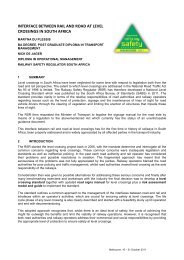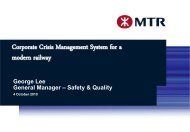successful interface risk management - International Rail Safety ...
successful interface risk management - International Rail Safety ...
successful interface risk management - International Rail Safety ...
Create successful ePaper yourself
Turn your PDF publications into a flip-book with our unique Google optimized e-Paper software.
Axel Kappeler, James Catmur<br />
Arthur D. Little<br />
Successful <strong>interface</strong> <strong>risk</strong> <strong>management</strong> – from blame culture to joint action<br />
Engineering meetings<br />
<strong>interface</strong><br />
• Technical solutions for<br />
feature fulfillment<br />
• Software (SW)<br />
• Hardware (HW)<br />
• V&V plan fulfillment<br />
– Uptime<br />
– Material deliveries<br />
(maturity of the material<br />
as one parameter)<br />
– Reliability growth rate<br />
(Problem solving speed,<br />
verification fulfillment)<br />
– Changes on Engine side<br />
--> leading to changes<br />
vehicle side<br />
Coordination meetings<br />
<strong>interface</strong><br />
• Feature fulfillment<br />
• Feature balancing<br />
• Business impact<br />
Planning meetings<br />
<strong>interface</strong><br />
• Vehicle to Powertrain:<br />
Material order from vehicle<br />
project of<br />
Engine/transmission<br />
deliveries<br />
• Priority of vehicles in the<br />
common plan<br />
• Vehicle to Powertrain: SW<br />
status on the truck to the<br />
engine<br />
• SW delivery plan, who is<br />
developing the SW?<br />
– Right SW in the right<br />
time for the right<br />
purpose is a key<br />
<strong>interface</strong>. The people<br />
working with the<br />
planning are stuck in<br />
short term firefighting<br />
• V&V for different engine<br />
types<br />
Other <strong>interface</strong><br />
Define the <strong>interface</strong> in terms<br />
of:<br />
• Quality & Features<br />
(technical aspects)<br />
• Delivery (timing)<br />
• Costs (product/project)<br />
• Managerial (control)<br />
Figure 1: Example <strong>interface</strong> definition based on existing meeting structure between two projects<br />
2. Identifying <strong>interface</strong> <strong>risk</strong>s<br />
There are two main approaches that can be taken to identify <strong>interface</strong> <strong>risk</strong>s:<br />
1. Bringing the parties together to identify the <strong>risk</strong>s at their <strong>interface</strong> jointly.<br />
2. Working with each party separately.<br />
In the first approach the parties that share an <strong>interface</strong> are brought together either physically in one meeting<br />
room or virtually via conference call and net-meeting.<br />
The approach used for identifying <strong>interface</strong> <strong>risk</strong>s is based the HAZOP 2 study technique and using<br />
Guidewords. HAZOP is an especially powerful technique for analysing <strong>interface</strong>s. [6,7,8,9]<br />
The approach consists of:<br />
• Defining a set of guidewords to identify <strong>interface</strong> <strong>risk</strong>s.<br />
• Applying the guidewords systematically to the <strong>interface</strong> (as defined in the first step) to identify<br />
potential <strong>risk</strong>s at the <strong>interface</strong>.<br />
• Recording the <strong>risk</strong>s in a <strong>risk</strong> register.<br />
2 Hazard and Operability<br />
London, 8 – 10 October 2012















